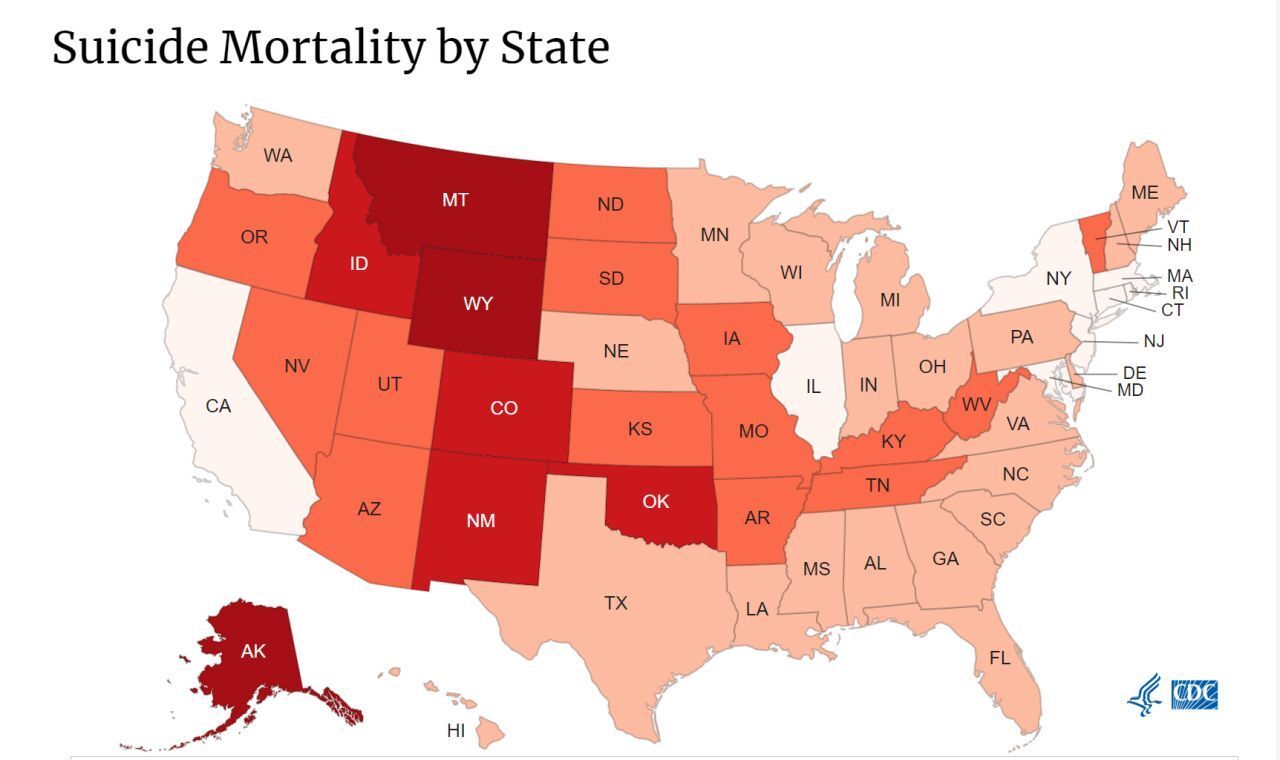GREAT FALLS - September is Suicide Prevention Month, and while we are nearing the end of the month, that doesn't mean the issue of suicide and mental health stop being important.
The Treasure State has ranked in the top five for suicide rates in the nation for the past 30 years, according to the Montana Department of Public Health & Human Services (DPHHS).
In a report for 2020 in the National Vital Statistics Report, the state has the third-highest rate of suicide in the nation (300 suicides for a crude rate of 25.9).
Firearms (62%), suffocation (20%), and poisoning (9%) are the most common means of suicide in Montana.
Other means include carbon monoxide, overdose, motor vehicle accidents, and jumping from heights.

Many Rivers Whole Health Director for Recovery Services Julie Prigmore says the health clinic deals with people who engage in suicidal thoughts or actions.
She discussed some of the causes they've noticed.
"Many of the common causes are social isolation, social disorganization, and usually it's pretty it's significant, but sometimes it's extremely subtle," she said. "One thing that we want to avoid is saying that you're just seeking attention."
She noted that alcoholism and major depression is what they tend to see in their clients.
"Depression is treatable. 86% of people who have therapy and medication can recover from depression and feel better. The statistic drops to 40-70% if they don't seek intervention," Prigmore said. "Alcoholism is treatable. We have substance use programs. Once you treat both, things will move in a more positive direction."
Prigmore added that there can be a stigma when it comes to discussing suicide or mental health.
"I think it's a combination of stigma, lack of understanding and fear that with stigma people, especially in Montana, we want to pull our bootstraps up, you know, just take care of it, be on our own, kind of get over it, move past it," Prigmore said. "And there's some sort of weakness, like when you're asking for help, which that is not the case."
Diane Stinger — the President of NAMI (National Alliance on Mental Illness) Great Falls — discussed some of the cues to recognize if a person is suicidal.
"People who are having suicidal thoughts might have verbal cues like 'I don't think I can live anymore,' 'I don't want to live anymore,' 'I wish I can die,' 'I should die,' things like that," Stinger said. "They might have behavioral issues, and sometimes you might not notice the cues."
DPHHS noted that in Montana, from 2011 to 2020, the youth suicide (ages 11-17) rate is 11.9/100,000 which is more than double the national rate for the same age group (4.98). In 2020, 62% of the youth suicides were by firearms.
Great Falls Public Schools Mental Health Coordinator Andrea Savage noted a disturbing statistic when it comes to the three high schools.
"We're seeing more teens think about suicide, more teens that are sad, depressed, and dealing with anxiety. This is affecting their ability to function in their schools, it affects their relationships and dynamics in their families," Savage said. "We have a youth risk behavioral survey that we do in conjunction with OPI. What we found locally is 46% of our high school kids...had thought about suicidality, and 11% attempted suicide.
She added the numbers were high in middle schools as well with 34% reporting that they've felt sad or hopeless on any given day. An estimated 11% of those kids attempt suicide.
Savage said there are various reasons these kids contemplate suicide, but some common themes she has noticed is that a lot of it has to do with perception, with social media playing a major role. She added that relationship conflicts can also have an impact as well as a black-and-white sort of thinking — a mentality where they feel as though nothing will get better.
She noted that there are different support systems she and Great Falls Public Schools have developed to deter this sort of behavior.
"Kids are talking to kids, they're not going to adults, so we really took a look at the systems put in place in supporting teens. What we've developed is a model of peer mentorship. There's a licensed therapist that facilitates the group, and school counselors, school psychologists, and what we do is train kids in mental health first aid," Savage explained.
"These might not be your most popular kids, but they are approachable and appear to be non-judgmental. We spend an hour a week on what to look as far as anxiety and depression in your friends, and then we give them first aid types of things to first aid the situation. Obviously, they come to myself, and we have six other licensed therapists in our school district as well as collaborations with outside providers as well," Savage continued.
Savage said that suicide is preventable in most cases, adding that it's simply a matter of taking action at the appropriate time.
"It's really about normalizing those topics around suicide," Savage explained. "Everybody feels anxious. Everybody feels sad. What are you going to do and what types of resources can we plug you in? Just really training them and training our teachers on what you can do in the moment."
If you are engaging in suicidal thoughts or actions, here are some free, 24/7 open resources to help:
- National Suicide Lifeline: call or text 988
- Text MT to 741-741
- Montana Suicide Prevention Lifeline: 800-273-Talk (8255)




